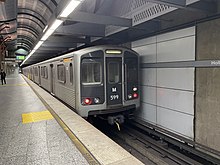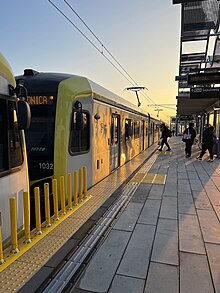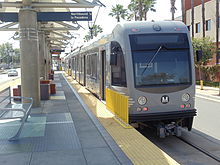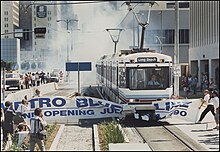Los Angeles Metro Rail
Los Angeles Metro Rail has been extended significantly since it started service in 1990, and several further extensions are either in the works or being considered.
[3] Stations include at least two ticket vending machines, wayfinding maps, electronic message displays, and bench seating.
Call boxes are available at stations to allow employees at the Metro Rail Operations Control Center to assist passengers with concerns.
[4] Street-level stations are typically simpler with platforms designed with shade canopies, separated from nearby roads and sidewalks, where passengers can purchase fares and board a train.
[10] Before the COVID-19 pandemic in March 2020, service operated until approximately 2:00 am on Fridays and Saturdays but was removed to accommodate train cleaning.
During early morning and late night hours, train frequency on all Metro Rail lines is reduced to every 20 minutes.
[2] As of the third quarter of 2024, the combined Metro B and D lines averaged a weekday ridership of 67,300, making it the ninth busiest rapid transit system in the United States.
Metro's light rail system is the second-busiest in the United States with 141,000 average weekday boardings as of the third quarter of 2024.
[1] In terms of route length, Metro's light rail system is the largest in the United States.
Half of the Metro Rail's trains and stations are patrolled by the Los Angeles County Sheriff's Department under a law enforcement contract.
[23] However, from 1927 revenue shortfall caused Pacific Electric to begin replacing lightly used rail lines with buses.
In 1958, the remnants of the privately owned rail and bus systems were consolidated into a government agency known as the Los Angeles Metropolitan Transit Authority or MTA.
[citation needed] In the following decades, growing traffic congestion led to increased public support for rail transit's return.
Beginning in the 1970s, a variety of factors, including environmental concerns, an increasing population, and the price of gasoline led to calls for mass transit other than buses.
[citation needed] The Los Angeles County Metropolitan Transportation Authority (LACMTA, now branded as Metro) began construction of the initial lines throughout the 1980s using revenues from a voter-approved increase in sales tax.
The following table shows this expansion's timeline: Just before the opening of the Metro Rail, Proposition U passed, which halved the allowable residential density throughout much of Los Angeles.
[33] Ridership declines also coincide with passage of AB 60, signed into law by Governor Jerry Brown in 2013, which provides for issuance of a driver's license regardless of immigration status.
[34][35] The fiscal changes are the passage of Measure R, a countywide incremental sales tax increase passed by voters in 2008, providing funding for many of the highest priority projects in the LRTP.
The voters then approved Measure M, a half-cent permanent sales tax increase to fund many local projects, including Metro Rail expansion.
[40] In 2018, Metro approved renaming its rail lines using a letter-based scheme, similar to those in New York City.
Some are listed as "strategic unfunded" in the last Long Range Transportation Plan, indicating some possibility they could be constructed should additional funding materialize.






